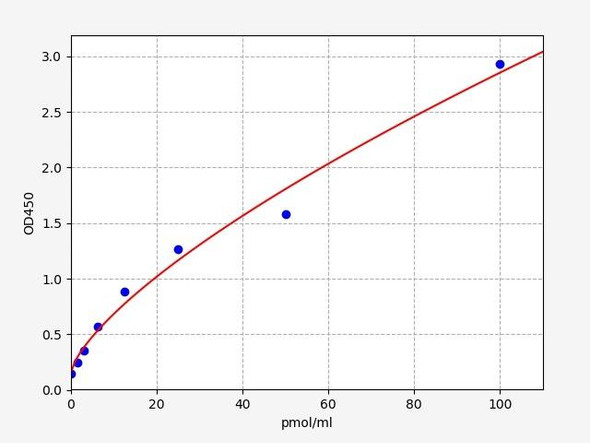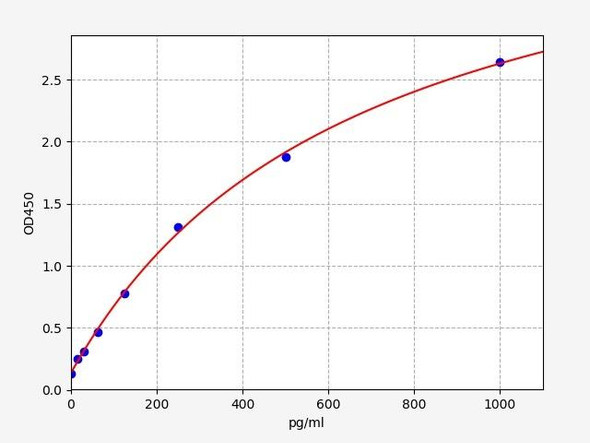Human Protein LYRIC (MTDH) ELISA Kit (HUEB1533)
- SKU:
- HUEB1533
- Product Type:
- ELISA Kit
- Size:
- 96 Assays
- Uniprot:
- Q86UE4
- Range:
- 1.56-100 nmol/L
- ELISA Type:
- Sandwich
- Synonyms:
- MTDH, Protein LYRIC, 3D3, AEG1, LYRIC, AEG-13D3, LYRIC, AEG1LYRIC, 3D3, Astrocyte elevated gene-1 protein, Metastasis adhesion protein, Lysine-rich CEACAM1 co-isolated protein, Metadherin
- Reactivity:
- Human
Description
Human Protein LYRIC (MTDH) ELISA Kit
The Human Protein Lyric (MTDH) ELISA Kit is a specialized assay designed for the quantitative measurement of MTDH (Metadherin) levels in human samples such as serum, plasma, and cell culture supernatants. This kit offers exceptional sensitivity and specificity, allowing for accurate and consistent results that are essential for various research applications.MTDH, also known as Lyric, is a protein known for its role in promoting tumor growth and metastasis in various types of cancer. Its overexpression has been linked to poor prognosis in cancer patients, making it a valuable biomarker for studying cancer progression and potential therapeutic interventions.
By utilizing the Human Protein Lyric (MTDH) ELISA Kit, researchers can gain valuable insights into the molecular mechanisms underlying cancer progression and potentially identify novel targets for cancer treatment. This kit provides a reliable tool for accurate quantification of MTDH levels, enabling researchers to further explore the role of this protein in cancer biology.
| Product Name: | Human Protein LYRIC (MTDH) ELISA Kit |
| SKU: | HUEB1533 |
| Size: | 96T |
| Target: | Human Protein LYRIC (MTDH) |
| Synonyms: | 3D3/LYRIC, Astrocyte elevated gene-1 protein, Lysine-rich CEACAM1 co-isolated protein, Metadherin, Metastasis adhesion protein, AEG-1, AEG1, LYRIC |
| Assay Type: | Sandwich |
| Detection Method: | ELISA |
| Reactivity: | Human |
| Detection Range: | 1.56-100nmol/L |
| Sensitivity: | 0.092nmol/L |
| Intra CV: | 3.2% | ||||||||||||||||||||
| Inter CV: | 6.5% | ||||||||||||||||||||
| Linearity: |
| ||||||||||||||||||||
| Recovery: |
| ||||||||||||||||||||
| Function: | Downregulates SLC1A2/EAAT2 promoter activity when expressed ectopically. Activates the nuclear factor kappa-B (NF-kappa-B) transcription factor. Promotes anchorage-independent growth of immortalized melanocytes and astrocytes which is a key component in tumor cell expansion. Promotes lung metastasis and also has an effect on bone and brain metastasis, possibly by enhancing the seeding of tumor cells to the target organ endothelium. Induces chemoresistance. |
| Uniprot: | Q86UE4 |
| Sample Type: | Serum, plasma, tissue homogenates, cell culture supernates and other biological fluids |
| Specificity: | Natural and recombinant human Protein LYRIC |
| Sub Unit: | Interacts with BCCIP, CREBBP/CBP and RELA/p65. |
| Research Area: | Epigenetics |
| Subcellular Location: | Endoplasmic reticulum membrane Single-pass membrane protein Nucleus membrane Single-pass membrane protein Cell junction Tight junction Nucleus Nucleolus Cytoplasm Perinuclear region In epithelial cells, recruited to tight junctions (TJ) during the maturation of the TJ complexes. A nucleolar staining may be due to nuclear targeting of an isoform lacking the transmembrane domain (By similarity). TNF-alpha causes translocation from the cytoplasm to the nucleus. |
| Storage: | Please see kit components below for exact storage details |
| Note: | For research use only |
| UniProt Protein Function: | Lyric: a protein of unknown function. |
| UniProt Protein Details: | Protein type:Membrane protein, integral; Nucleolus; Cell adhesion Chromosomal Location of Human Ortholog: 8q22.1 Cellular Component: nuclear body; intercellular canaliculus; endoplasmic reticulum membrane; nuclear membrane; tight junction; endoplasmic reticulum; perinuclear region of cytoplasm; apical plasma membrane; cytoplasm; nucleolus; integral to membrane; nucleus Molecular Function:NF-kappaB binding; protein binding; double-stranded RNA binding; transcription coactivator activity Biological Process: positive regulation of protein kinase B signaling cascade; positive regulation of angiogenesis; positive regulation of I-kappaB kinase/NF-kappaB cascade; lipopolysaccharide-mediated signaling pathway; negative regulation of transcription from RNA polymerase II promoter; positive regulation of autophagy; negative regulation of apoptosis; activation of NF-kappaB transcription factor |
| UniProt Code: | Q86UE4 |
| NCBI GenInfo Identifier: | 28277147 |
| NCBI Gene ID: | 92140 |
| NCBI Accession: | AAH45642.1 |
| UniProt Secondary Accession: | Q86UE4,Q05DH2, Q52QU9, Q6PK07, Q8TCX3, |
| Molecular Weight: | 63,837 Da |
| NCBI Full Name: | Metadherin |
| NCBI Synonym Full Names: | metadherin |
| NCBI Official Symbol: | MTDH |
| NCBI Official Synonym Symbols: | 3D3; AEG1; AEG-1; LYRIC; LYRIC/3D3 |
| NCBI Protein Information: | protein LYRIC |
| UniProt Protein Name: | Protein LYRIC |
| UniProt Synonym Protein Names: | 3D3/LYRIC; Astrocyte elevated gene-1 protein; AEG-1; Lysine-rich CEACAM1 co-isolated protein; Metadherin; Metastasis adhesion protein |
| Protein Family: | Protein LYRIC |
| UniProt Gene Name: | MTDH |
| UniProt Entry Name: | LYRIC_HUMAN |
| Component | Quantity (96 Assays) | Storage |
| ELISA Microplate (Dismountable) | 8×12 strips | -20°C |
| Lyophilized Standard | 2 | -20°C |
| Sample Diluent | 20ml | -20°C |
| Assay Diluent A | 10mL | -20°C |
| Assay Diluent B | 10mL | -20°C |
| Detection Reagent A | 120µL | -20°C |
| Detection Reagent B | 120µL | -20°C |
| Wash Buffer | 30mL | 4°C |
| Substrate | 10mL | 4°C |
| Stop Solution | 10mL | 4°C |
| Plate Sealer | 5 | - |
Other materials and equipment required:
- Microplate reader with 450 nm wavelength filter
- Multichannel Pipette, Pipette, microcentrifuge tubes and disposable pipette tips
- Incubator
- Deionized or distilled water
- Absorbent paper
- Buffer resevoir
*Note: The below protocol is a sample protocol. Protocols are specific to each batch/lot. For the correct instructions please follow the protocol included in your kit.
Allow all reagents to reach room temperature (Please do not dissolve the reagents at 37°C directly). All the reagents should be mixed thoroughly by gently swirling before pipetting. Avoid foaming. Keep appropriate numbers of strips for 1 experiment and remove extra strips from microtiter plate. Removed strips should be resealed and stored at -20°C until the kits expiry date. Prepare all reagents, working standards and samples as directed in the previous sections. Please predict the concentration before assaying. If values for these are not within the range of the standard curve, users must determine the optimal sample dilutions for their experiments. We recommend running all samples in duplicate.
| Step | |
| 1. | Add Sample: Add 100µL of Standard, Blank, or Sample per well. The blank well is added with Sample diluent. Solutions are added to the bottom of micro ELISA plate well, avoid inside wall touching and foaming as possible. Mix it gently. Cover the plate with sealer we provided. Incubate for 120 minutes at 37°C. |
| 2. | Remove the liquid from each well, don't wash. Add 100µL of Detection Reagent A working solution to each well. Cover with the Plate sealer. Gently tap the plate to ensure thorough mixing. Incubate for 1 hour at 37°C. Note: if Detection Reagent A appears cloudy warm to room temperature until solution is uniform. |
| 3. | Aspirate each well and wash, repeating the process three times. Wash by filling each well with Wash Buffer (approximately 400µL) (a squirt bottle, multi-channel pipette,manifold dispenser or automated washer are needed). Complete removal of liquid at each step is essential. After the last wash, completely remove remaining Wash Buffer by aspirating or decanting. Invert the plate and pat it against thick clean absorbent paper. |
| 4. | Add 100µL of Detection Reagent B working solution to each well. Cover with the Plate sealer. Incubate for 60 minutes at 37°C. |
| 5. | Repeat the wash process for five times as conducted in step 3. |
| 6. | Add 90µL of Substrate Solution to each well. Cover with a new Plate sealer and incubate for 10-20 minutes at 37°C. Protect the plate from light. The reaction time can be shortened or extended according to the actual color change, but this should not exceed more than 30 minutes. When apparent gradient appears in standard wells, user should terminatethe reaction. |
| 7. | Add 50µL of Stop Solution to each well. If color change does not appear uniform, gently tap the plate to ensure thorough mixing. |
| 8. | Determine the optical density (OD value) of each well at once, using a micro-plate reader set to 450 nm. User should open the micro-plate reader in advance, preheat the instrument, and set the testing parameters. |
| 9. | After experiment, store all reagents according to the specified storage temperature respectively until their expiry. |
When carrying out an ELISA assay it is important to prepare your samples in order to achieve the best possible results. Below we have a list of procedures for the preparation of samples for different sample types.
| Sample Type | Protocol |
| Serum | If using serum separator tubes, allow samples to clot for 30 minutes at room temperature. Centrifuge for 10 minutes at 1,000x g. Collect the serum fraction and assay promptly or aliquot and store the samples at -80°C. Avoid multiple freeze-thaw cycles. If serum separator tubes are not being used, allow samples to clot overnight at 2-8°C. Centrifuge for 10 minutes at 1,000x g. Remove serum and assay promptly or aliquot and store the samples at -80°C. Avoid multiple freeze-thaw cycles. |
| Plasma | Collect plasma using EDTA or heparin as an anticoagulant. Centrifuge samples at 4°C for 15 mins at 1000 × g within 30 mins of collection. Collect the plasma fraction and assay promptly or aliquot and store the samples at -80°C. Avoid multiple freeze-thaw cycles. Note: Over haemolysed samples are not suitable for use with this kit. |
| Urine & Cerebrospinal Fluid | Collect the urine (mid-stream) in a sterile container, centrifuge for 20 mins at 2000-3000 rpm. Remove supernatant and assay immediately. If any precipitation is detected, repeat the centrifugation step. A similar protocol can be used for cerebrospinal fluid. |
| Cell culture supernatant | Collect the cell culture media by pipette, followed by centrifugation at 4°C for 20 mins at 1500 rpm. Collect the clear supernatant and assay immediately. |
| Cell lysates | Solubilize cells in lysis buffer and allow to sit on ice for 30 minutes. Centrifuge tubes at 14,000 x g for 5 minutes to remove insoluble material. Aliquot the supernatant into a new tube and discard the remaining whole cell extract. Quantify total protein concentration using a total protein assay. Assay immediately or aliquot and store at ≤ -20 °C. |
| Tissue homogenates | The preparation of tissue homogenates will vary depending upon tissue type. Rinse tissue with 1X PBS to remove excess blood & homogenize in 20ml of 1X PBS (including protease inhibitors) and store overnight at ≤ -20°C. Two freeze-thaw cycles are required to break the cell membranes. To further disrupt the cell membranes you can sonicate the samples. Centrifuge homogenates for 5 mins at 5000xg. Remove the supernatant and assay immediately or aliquot and store at -20°C or -80°C. |
| Tissue lysates | Rinse tissue with PBS, cut into 1-2 mm pieces, and homogenize with a tissue homogenizer in PBS. Add an equal volume of RIPA buffer containing protease inhibitors and lyse tissues at room temperature for 30 minutes with gentle agitation. Centrifuge to remove debris. Quantify total protein concentration using a total protein assay. Assay immediately or aliquot and store at ≤ -20 °C. |
| Breast Milk | Collect milk samples and centrifuge at 10,000 x g for 60 min at 4°C. Aliquot the supernatant and assay. For long term use, store samples at -80°C. Minimize freeze/thaw cycles. |










